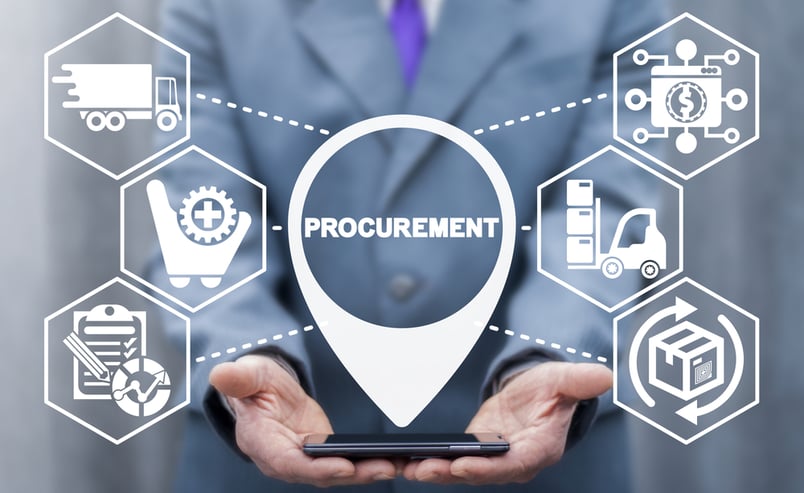Leveraging AI to Mitigate Common Procurement Contract Risks

Today’s global supply chain challenges highlight the need for procurement efficiencies and better risk management. Many corporate legal departments are facing new vendor challenges and situations not covered by legacy contracting policies and procedures.

They must now navigate the risks inherent in procurement contracts, like poor needs analysis, agreement management, vendor issues, and compliance risks. By leveraging artificial intelligence (AI), legal departments are discovering effective and efficient strategies for mitigating common procurement contract risks and providing automated contract evaluations that are on par with—or better than—an attorney review.
Types of Procurement Contracts
There is not only one type of contract to consider when evaluating risks. Companies may use a wide range of procurement contract types to obtain needed supplies and services. These agreements typically fall into one of three categories.
|
Cost-Reimbursable |
Fixed Price |
Time and Materials |
|
These agreements are sometimes called "cost-plus" contracts. Contractors are reimbursed for the expenses they incur in the course of the work. Cost-reimbursable contracts are often used when the overall financial cost of the project is difficult to predict. Risk is inherent here, as the buyer may see prices escalate to a point where the work is no longer feasible. |
Fixed-price contracts are among the simplest procurement agreements because they are based on a specified budget and time frame. This type of agreement is very transactional and can be ideal for short-term, one-time contracts. They frequently favor the buyer because expectations are enumerated clearly. However, the seller could face issues related to ambiguities or poor budget planning that must be addressed. |
Time and materials contracts combine components of cost-reimbursed and fixed-price contracts. The vendor will receive reimbursement for the materials they purchase, as well as a fixed rate for labor. These contracts require extensive communication and can lead to issues with over-inflated expenses or time spent on a project. They must be carefully and closely managed and regularly audited. |
All of these contracts carry inherent risks that require review. Legal departments should ensure that the contract they choose is the best fit for the project.
What Type of Procurement Contract is Best?
One procurement contract risk that is easy to overlook is the initial choice of contract type. When corporate legal departments deal with a new vendor, they may compare their services to a previous vendor and fit the procurement contract into that type. If incorrectly categorized, the legal department may not have the resources to manage the agreement risks.
- Fixed price – It is necessary that someone on the seller side of a fixed price contract analyzes the terms thoroughly. It is not uncommon to get into a race to the bottom when trying to compete with others. As a result, companies may find themselves operating at a loss. Procurement risk management, in this case, requires extensive future financial modeling to determine the best price.
- Cost-reimbursable – Cost reimbursable contracts require extensive, repeated communication with vendors to avoid scope creep. Legal departments must collaborate closely with accounting to monitor expenditures and manage budgets.
- Time and materials – Time and materials contracts are particularly popular because they can cover all of the needs of a business relationship. However, they can also produce excessive paperwork, like invoices and timesheets, that must be reviewed carefully to minimize cost inflation risks.
Choosing the right procurement contract type can enable companies to effectively mitigate risks; however, even the best contract choice will contain additional risks inherent in any procurement agreement.
Common Procurement Contract Risks
The most common procurement contract risks can be grouped into four distinct categories: insufficient needs analysis, bad vendor vetting, poor contract management, and compliance.
|
Insufficient needs analysis |
|
A department in a hurry to put a contract to bed may make mistakes in assessing needs related to deadlines, budget, inventory, and more. Ambiguous requirements may also make it challenging to understand the potential scope of a project. |
|
Bad vendor vetting |
|
While predicting all future vendor behavior is impossible, companies can note and prepare for red flags in the early contract stages. For instance, companies commonly make the error of choosing a vendor strictly based on price point, as reduced costs could result in subpar materials, missed deadlines, and inflated invoices. In the worst cases, a company may become a victim of fraud or get entangled in ethical issues. |
|
Poor contract management |
|
Problems can also arise from the administrative side of contract management. Companies may fail to track necessary paperwork or follow proper negotiation procedures. Multiple copies of the same contract—with slightly different terms—may be in the hands of various parties. This kind of issue results from a lack of organization and unclear communications. |
|
Compliance |
|
Compliance issues apply to governmental or heavily regulated agreements. These entities have specific benchmarks for management that require review. Failure to meet these standards could result in fines, penalties, and contract cancellation. |
Procurement is complex, and its associated risks can be hard to track with most traditional contract management strategies. To better manage these issues, innovative legal departments are leveraging AI to conduct contract analytics for managing and mitigating risk.
Using AI for Procurement Risk Management
AI offers a second set of eyes for corporate legal departments seeking better control over procurement processes. An AI-powered risk solution leverages a sample set of contracts, Natural Language Processing (NLP), and other strategies to review documents and make suggestions. With AI, contract review can be completed in a fraction of the time it would take a human attorney. AI contract review is comprised of four stages: analysis, revisions, contract negotiations, and management.
|
Analyze |
Revise |
|
During analysis, the AI employs a sample set of documents and other organization-specific information to read through a contract. The AI will compare contract sections to the company's preferred positions and policies. Based on this assessment, the AI will then flag potential areas of concern. |
After targeting specific areas of concern, the AI will return revision suggestions. For example, it may note that a contract is missing a clause that would protect the company in the event of occurrences out of their control, like natural disasters. Then, the AI would recommend an appropriate clause to cover that issue. |
|
Negotiate |
Manage |
|
Many corporate legal departments use negotiation playbooks for contract standardization. The best AI solutions incorporate a Digital AI Playbook into the review. With the help of a digital playbook, attorneys can target necessary areas for negotiation and accelerate the approval process. |
Digitizing contracts helps eliminate issues with redundancy since the digital platform holds the most recent version. This can also allow organizations to add these contracts to a management database that will help them track deadlines and monitor terms. |
Choosing the Right AI Contract Review Solution
Two basic types of contract review software should be understood when determining the best solution for your legal department: text extraction software versus a fully automated authoring and redlining solution.
|
Text Extraction |
Fully Automated Authoring and Redlining |
|
Extraction software reviews documents and extracts common sections. That information then guides future agreements and may contribute to establishing a management database. This technology works well for bulk contract management, though it may be of little use in negotiating agreements and is used primarily in mining data from legacy, post-signature agreements.. |
These solutions review contracts, redline terms of concern, and offer suggestions for improvement. The technology is more akin to an actual attorney review. As a result, a fully automated solution can act as a negotiation aid and help attorneys focus their attention on key provisions that will lead to preferred negotiating positions and mitigation on contracting risk. |
A fully automated AI contract review solution is highly effective in mitigating common procurement contract risks. It can help guide companies to the right provisions and language that will facilitate better business outcomes. By leveraging this technology, corporate legal departments can improve contract management and make better procurement decisions.
LexCheck provides a fully-automated contract review platform that can mitigate common procurement contract risks and facilitate negotiations. Reach out to our team at sales@lexcheck.com to learn more, or request a demo to experience the benefits first-hand.